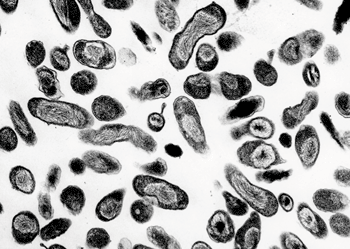Interferon Gamma Assay Detects Chronic Q Fever
By LabMedica International staff writers
Posted on 17 Jul 2013
The diagnosis of Q fever, caused by the intracellular pathogen Coxiella burnetii, relies mainly on serology and skin tests (STs)—both with drawbacks.Posted on 17 Jul 2013
A C. burnetii-specific interferon gamma (IFN-γ) production has been used as a diagnostic tool for past Q fever infection that circumvented most of these shortcomings, and was compared with serology and ST.

Image: Coxiella burnetii (Photo courtesy of Rocky Mountain Laboratories).
Scientists at the Radboud University (Nijmegen, The Netherlands) enrolled 1,525 individuals from an endemic area with a risk for chronic Q fever. IFN-γ production was measured after in vitro stimulation of whole blood with C. burnetii antigens. Various formats using different C. burnetii antigens were tested and serology and ST were performed on all individuals.
The amount of IFN-γ was measured by enzyme-linked immunosorbent assay (ELISA). Serological and ST results were unknown to those performing the assay. Net IFN-γ production was expressed as the concentration of IFN-γ in stimulated samples minus that in negative controls. If either IFN-γ production in the negative control exceeded 24 pg/mL, which is three times the lower detection limit of the ELISA, or the IFN-γ production after phytohemagglutinin (PHA) stimulation was less than24 pg/mL without the C. burnetii-stimulated aliquots exceeding 24 pg/mL, then the assay was considered inconclusive.
In all assay formats, C. burnetii-specific IFN-γ production was higher in seropositive or ST-positive subjects than in seronegative and ST-negative subjects. Whole blood incubated for 24 hours with the heat-inactivated laboratory C. burnetii Nine Mile strain showed optimal performance. After excluding subjects with equivocal serology and/or borderline ST results, IFN-γ production was 449 ± 82 pg/mL in 219 positive individuals, but only 21 ± 3 pg/mL in 908 negative subjects. The IFN-γ assay had a sensitivity of 87.0% and the specificity was 90.2%, which was similar to the combination of serology and ST at 83.0% sensitivity and 95.6% specificity.
The authors concluded that specific IFN-γ detection is a novel diagnostic assay for previous C. burnetii infection and shows similar performance and practical advantages over serology and ST. However, they recommend that the assay as being complimentary to serological tests, with added value in cases with equivocal serology. The additional value of the assay in active Q fever disease, both the acute and chronic form, is currently being addressed. The study was originally published online on March 5, 2013, in the journal Clinical Infectious Diseases.
Related Links:
Radboud University














